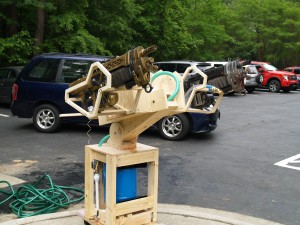I’ve been holding off on posting about this until I got some time to finish it up, but now seems like a good time since it was mentioned in a community blog post.

I didn’t capture a proper video of it in action, but there are a couple snippets in this awesome picnic compilation video put together by Aaron:
The cannon uses a pre-pressurized water bladder, typically used to smooth out variations in water pressure for houses or RVs. The pressure of the output water will be roughly the same as the water supply used to charge the tank (and it can also be run in ‘continuous’ mode by leaving the hose connected). At the picnic site, the park water supply pressure was crazy high, which resulted in very nice performance. However, I saw about 90 psi on the pressure gauge at one point, which is uncomfortably close to the tank safety rating.
The drive electronics are just an Arduino that sequences four relays in turn controlling the sprinkler valve solenoids.
